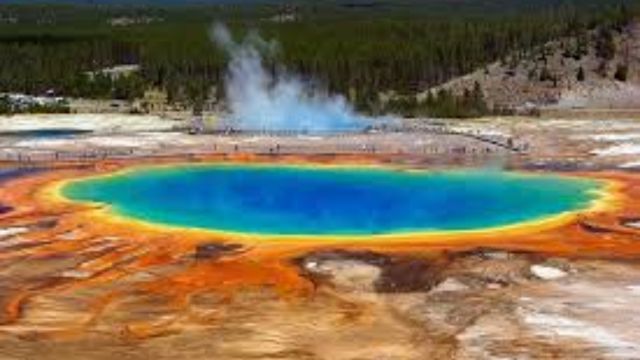Yellowstone National Park, a pioneering preserve in the United States and possibly the world, spans 3,468 square miles across Wyoming, Idaho, and Montana. It’s a hub for nearly two million annual visitors, offering a dozen campgrounds and over 2,000 campsites. The park’s fame partly lies in its volcanic phenomena, thanks to the dormant supervolcano, the Yellowstone Caldera, beneath it. Among its geothermal wonders, the Grand Prismatic Spring stands out as a major attraction.
The Grand Prismatic Spring: A Natural Marvel
Renowned for its stunning color palette, the Grand Prismatic Spring displays a vibrant blue core encircled by rings that transition through various colors—green, red, yellow—depending on the season. As the United States’ largest hot spring, it measures 370 feet across.
However, its inviting colors belie the danger it poses, with temperatures around 160 degrees Fahrenheit, far beyond human tolerance for hot water. The park provides viewing platforms and walkways for safe observation, steering clear of any direct contact.
Historical Context
First noted by Euro-American settlers in 1839, the Grand Prismatic Spring’s history with human interaction stretches back over 11,000 years, serving Indigenous peoples for culinary and medicinal purposes. Contrary to myths propagated during the park’s early days, Indigenous communities such as the Shoshone, Crow, Blackfeet, and Kiowa, thrived in and around Yellowstone, utilizing its resources. The spring received its official name from the 1871 Hayden Expedition, inspired by its prism-like colors.
Geographical Significance
Perched at 7,270 feet above sea level, the spring is a deep, geothermal spectacle, discharging 560 gallons per minute from a fissure deep within the Earth. It’s the world’s third-largest hot spring, with a size exceeding an American football field. Nearby, the once-vigorous Excelsior Geyser now functions as a serene hot spring, having ceased its dramatic eruptions.
The Source of Its Spectacular Colors
The spring’s remarkable hues originate not from minerals but from thermophile bacteria thriving in varying temperatures across the spring. The center’s intense heat keeps it a brilliant blue, free from bacterial life, while the cooler, outer rings support a colorful array of these organisms.
Seasonal changes further influence these colors. Notably, research on these bacteria has significantly advanced scientific fields, including genetics and medical testing, showcasing the invaluable contributions of Yellowstone’s ecosystem to global knowledge.
The Grand Prismatic Spring, alongside Yellowstone’s other geological and natural wonders, represents a must-visit landmark that captures the awe-inspiring beauty and scientific intrigue of the natural world.

